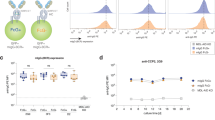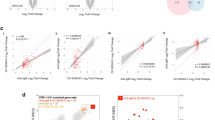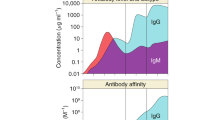Abstract
The induction of a humoral response depends upon efficient cross-linking by antigen of surface immunoglobulin on primary B lymphocytes. We demonstrate here the presence of a glycosylphosphatidylinositol-linked isoform of membrane IgD (mIgD) receptors on murine resting B cells. This subset was constitutively localized to cell membrane raft microdomains. Its stimulation resulted in the activation of cAMP-dependent signaling pathways, which integrated with signals derived from the transmembrane mIgD receptors. This, in turn, provided a mechanism by which the activation status of the target cells could be variably regulated. Thus, by partitioning receptor activity, preimmune B cells can moderate the extent to which they are activated, depending upon the strength of the antigenic stimulus.
This is a preview of subscription content, access via your institution
Access options
Subscribe to this journal
Receive 12 print issues and online access
$209.00 per year
only $17.42 per issue
Buy this article
- Purchase on Springer Link
- Instant access to full article PDF
Prices may be subject to local taxes which are calculated during checkout






Similar content being viewed by others
References
Benschop, R.J. & Cambier, J.C. B cell development: signal transduction by antigen receptors and their surrogates. Curr. Opin. Immunol. 11, 143–151 (1999).
Lam, K.P., Kuhn, R. & Rajewski, K. In vivo ablation of surface immunoglobulin on mature B cells by inducible gene targeting results in rapid cell death. Cell 90, 1073–1083 (1997).
Campbell, K.S. Signal transduction from the B cell receptor. Curr. Opin. Immunol. 11, 256–264 (1996).
Kurosaki, T. Genetic analysis of B cell antigen receptor signaling. Annu. Rev. Immunol. 17, 555–592 (1999).
Glynne, R. et al. How self-tolerance and the immunosuppressive drug FK506 prevent B cell mitogenesis. Nature 403, 672–676 (2000).
Nossal, G.J.V. Differentiation of the secondary B lymphocyte repertoire: the germinal center reaction. Immunol. Rev. 137, 173–184 (1994).
Manser, T. et al. The roles of antibody variable region hypermutation and selection in the development of the memory B cell compartment. Immunol. Rev. 162, 182–196 (1998).
Mond, J.J., Sehgal, E., Kung, J. & Finkleman, F.D. Increased expression of I-region-associated antigen (Ia) on B cells after cross-linking of surface immunoglobulin. J. Immunol. 127, 881–888 (1981).
George, J. & Claflin, L. Selection of B cell clones and memory B cells. Semin. Immunol. 4, 11–17 (1992).
Lenschow, D.J. et al. Differential upregulation of the B7.1 and B7.2 costimulatory molecules after Ig receptor engagement by antigen. J. Immunol. 153, 1990–1997 (1994).
Rose, M.L., Birbeck, M.S.C., Wallis, W.J., Forrester, J.A. & Davies, J.S. Peanut lectin binding properties of germinal centres of mouse lymphoid tissue. Nature 284, 364–366 (1980).
Hardy, R., Hayakawa, K., Parks, D.R. & Herzenberg, L.A. Murine B cell differentiation lineages. J. Exp. Med. 159, 1169–1191 (1984).
Lalor, P.A., Nossal, G.J.V, Sanderson, R.D. & McHeyzer-Williams, M.G. Functional and molecular characterization of single (4-hydroxy-3-nitrophenyl)acetyl (NP)-specific IgG1+ B cells from antibody secreting and memory B cell pathways in C57Bl/6 immune response to NP. Eur. J. Immunol. 22, 3001–3011 (1992).
Han, S. et al. V(D)J recombinase activity in a subset of germinal center B lymphocytes. Science 278, 301–305 (1997).
Kimota, H. et al. Accumulation of somatic hypermutation and antigen-driven selection in rapidly cycling surface Ig+ germinal center (GC) B cells which occupy GC at a high frequency during a primary anti-hapten response in mice. Eur. J. Immunol. 27, 268–279 (1997).
Lahvis, G.P. & Cerny, J. Induction of germinal center B cell markers in vitro by activated CD4+ T lymphocytes. J. Immunol. 159, 1783–1793 (1997).
Koni, P.A. & Flavell, R.A. Lymph node germinal centers form in the absence of follicular dendritic cells. J. Exp. Med. 189, 855–864 (1999).
Galibert, L. et al. CD40 and B cell antigen receptor dual triggering of resting B lymphocytes turns on a partial germinal center phenotype. J. Exp. Med. 183, 77–85 (1996).
Morokata, T., Kato, T., Igarashi, O. & Nariuchi, H. Mechanism of enhanced antigen presentation by B cells activated with anti-μ plus interferon-γ: role of B7-2 in the activation of naïve and memory CD4+ T cells. Eur. J. Immunol. 25, 1992–1998 (1995).
Agarwal, A., Nayak, B.P. & Rao, K.V.S. B cell responses to a peptide epitope. VII. Antigen-dependent modulation of the germinal center reaction. J. Immunol. 161, 5832–5841 (1998).
Rooij, J. et al. Epac is a Rap1 guanine-nucleotide-exchange factor directly activated by cyclic AMP. Nature 396, 474–477 (1998).
Simons, K. & Ikonen, E. Functional rafts in cell membranes. Nature 387, 569–572 (1997).
Horejsi, V. et al. GPI-microdomains: a role in signaling via immunoreceptors. Immunol. Today 20, 356–361 (1999).
Langlet, C., Bernard, A.-M., Drevot, P. & He, H.-T. Membrane rafts and signaling by the multichain immune recognition receptors. Curr. Opin. Immunol. 12, 250–255 (2000).
Cherukuri, A., Dykstra, M. & Pirece, S.K. Floating the raft hypothesis: Lipid rafts play a role in immune cell activation. Immunity 14, 657–660 (2001).
Anderson, H.A., Hiltbold, E.M. & Roche, P.A. Concentration of MHC class II molecules in lipid rafts facilitates antigen presentation. Nature Immunol. 1, 156–162 (2000).
Guo, B., Kato, R.M., Garcia-Lioret, Wahl, M.I. & Rawlings, D.J. Engagement of the human pre-B cell receptor generates a lipid raft-dependent calcium signaling complex. Immunity 13, 243–253 (2000).
Dykstra, M.L., Longnecker, R. & Pierce, S.K. Epstein-Barr virus co-opts lipid rafts to block the signaling and antigen transport functions of the BCR. Immunity 14, 57–67 (2001).
Sproul, T.W., Malapati, S., Kim, J. & Pierce, S.K. B cell antigen receptor signaling occurs outside lipid rafts in immature B cells. J. Immunol. 165, 6020–6023 (2000).
Weintraub, B.C. et al. Entry of B cell receptor into signaling domains is inhibited in tolerant B cells. J. Exp. Med. 191, 1443–1448 (2000).
Chung, J.B., Baumeister, M.A. & Monroe, J.G. Differential sequestering of plasma membrane-associated B cell antigen receptor in mature and immature B cells into glycosphingolipid-enriched domains. J. Immunol. 166, 736–740 (2001).
Cheng, P.C., Dykstra, M.L., Mitchell, R.N. & Pierce, S.K. A role for lipid rafts in BCR signaling and antigen targeting. J. Exp. Med. 190, 1549–1560 (1999).
Cheng, P.C., Brown, B.K., Song, W. & Pierce, S.K. Translocation of B cell antigen receptor into lipid rafts reveals a novel step in signaling. J. Immunol. 166, 3693–3701 (2001).
Petrie, R.J., Schnetkamp, P.P.M., Patel, K.D., Awasthi-Kalia, M. & Deans, J.P. Transient translocation of the B cell receptor and src homology 2 domain- containing inositol phosphatase to lipid rafts: evidence toward a role in calcium regulation. J. Immunol. 165, 1220–1227 (2000).
Aman, M.J. & Ravichandran, K.S. A requirement for lipid rafts in B cell receptor induced Ca2+ flux. Curr. Biol. 10, 393–396.
Wienands, J. & Reth, M. Glycosyl-phosphatidylinositol linkage as a mechanism for cell-surface expression of immunoglobulin D. Nature 356, 246–248 (1992).
Yuan-Tseng, P. et al. Inhibition of glycosylphosphatidylinositol anchor formation by Mannosamine. J. Biol. Chem. 267, 21250–21255 (1992).
Pure, E. & Tardelli, L. Tyrosine phosphorylation is required for ligand-induced internalization of the antigen receptor on B lymphocytes. Proc. Natl. Acad. Sci. USA 89, 114–118 (1992).
Ghosh, S., May, J.M. & Kopp, E.B. NF-κB and Rel proteins: evolutionarily conserved mediators of immune responses. Annu. Rev. Immunol. 16, 225–260 (1998).
Yamanoto, K.K., Gonzalez, G.A., Biggs, W.H. & Montminy, M.R. Phosphorylation-induced binding and transcriptional efficacy of nuclear factor CREB. Nature 334, 494–497 (1988).
Natarajan, K., Sahoo, N.C. & Rao, K.V.S. Signal thresholds and modular synergy during expression of costimulatory molecules in B lymphocytes. J. Immunol. 167, 114–122 (2001).
Glynne, R., Ghandour, G., Rayner, J., Mack, D.H. & Goodnow, C.C. B lymphocyte quiescence, tolerance and activation as viewed by global gene expression profiling on microarrays. Immunol. Rev. 176, 216–246 (2000).
Cambier, J.C. & Ransom, J.T. Molecular mechanisms of transmembrane signals in B lymphocytes. Annu. Rev. Immunol. 5, 175–199 (1997).
Kouskoff, V. et al. Antigens varying in affinity for the B cell receptor induce differential B lymphocyte responses. J. Exp. Med. 188, 1453–1464 (1998).
Brink, R., Goodnow, C.C. & Basten, A. IgD expression on B cells is more efficient than IgM but both receptors are functionally equivalent in up-regulating CD80/CD86 co-stimulatory molecules. Eur. J. Immunol. 25, 1980–1984 (1995).
Roes, J. & Rajewsky, K. Immunoglobulin D (IgD)-deficient mice reveal an auxiliary receptor function for IgD in antigen-mediated recruitment of B cells. J. Exp. Med. 177, 45–55 (1993).
Harlow, E. & Lane, D. Antibodies: A laboratory manual (Cold Spring Harbor, ME, Cold Spring Harbor Laboratory Press, 1988).
Manivel, V., Bayiroglu, F., Siddiqui, Z., Salunke, D.M. & Rao, K.V.S. The primary antibody repertoire represents a linked network of degenerate antigen specificities. J. Immunol. 169, 888–897 (2002).
Acknowledgements
Supported by a grant from the Indian Council of Medical Research (to K. V. S. R.).
Author information
Authors and Affiliations
Corresponding author
Ethics declarations
Competing interests
The authors declare no competing financial interests.
Supplementary information
Web Fig. 1.
Activation of resting B lymphocytes with anti-IgD. Purified resting B cells were stimulated with a final concentration of 10 μg/ml of anti-IgD as described in the Methods. Following this, cells were analyzed for surface expression of the markers indicated by flow cytometry (a). Labeling with the appropriate isotype-matched control Ig yielded profiles that were superimposable with those for unstimulated cells. Results depicted are representative of eight independent experiments. (b) GCs obtained when anti-IgD-stimulated B cells were loaded with peptide CT3 and transferred into CT3-primed BALB/c IgHb mice (left panel). Specific GCs were identified as those containing IgHa-specific (IgG1a plus IgMa, red) and PNA+ (blue) cells. The right panel shows the empty follicles in CT3-primed BALB/c IgHb mice that had received peptide CT3-loaded unstimulated cells. (PDF 1065 kb)
Web Fig. 2.
Membrane distribution of sIgD receptors. Detergent-insoluble (fractions 4-6) and -soluble (fractions 10-12) fractions from cells lysed in Triton X-100 were resolved on a 10% polyacrylamide gel and then transferred onto a nitrocellulose membrane. These were then immunoblotted for GM1 ganglioside with biotinylated choleratoxin B subunit (CTB) or for IgD (sIgD) or CD45R (B220). The distribution of sIgD receptors in unstimulated cells and in cells stimulated with 10 μg/ml of anti-IgD (5 min at 37 °C) are shown in the panels identified as sIgD(u) and sIgD(s), respectively. The lowest panel, described as CTB(mcd), shows the effect of treatment of cells with MCD (10 mM) on GM1 gangliosides. (PDF 255 kb)
Rights and permissions
About this article
Cite this article
Chaturvedi, A., Siddiqui, Z., Bayiroglu, F. et al. A GPI-linked isoform of the IgD receptor regulates resting B cell activation. Nat Immunol 3, 951–957 (2002). https://doi.org/10.1038/ni839
Received:
Accepted:
Published:
Issue Date:
DOI: https://doi.org/10.1038/ni839
This article is cited by
-
Endocytosed BCRs sequentially regulate MAPK and Akt signaling pathways from intracellular compartments
Nature Immunology (2011)
-
Immunology in India: an emerging story
Nature Immunology (2008)
-
Growth inhibition of myeloma cells by anti‐idiotype antibodies in the absence of membrane‐bound immunoglobulin
Immunology & Cell Biology (2008)
-
Capturing cell‐fate decisions from the molecular signatures of a receptor‐dependent signaling response
Molecular Systems Biology (2007)
-
Directing B-cell destiny
Nature Reviews Immunology (2002)



